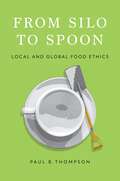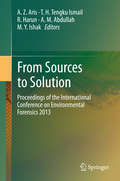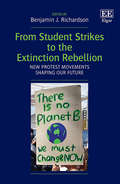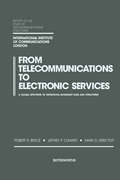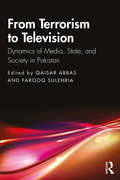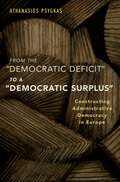- Table View
- List View
From Saviour to Guarantor: EU Member States’ Economic Intervention During the Financial Crisis (Roma Tre Business and Finance Collection)
by Fabio Bassan Carlo D. MotturaState guarantees commonly function as financial panacea, allowing states to consolidate banking systems and create intergovernmental funds. Rules surrounding state guarantees were relaxed during the 2007-2008 financial crisis, allowing states to use them for financing small and medium-sized enterprises (SMEs) and workers' severance payments. Despite many multi-level interventions in many areas after the financial crisis, from international treaties to EU regulations, no specific regulation has been put in place to control state guarantees. This book addresses the subject of state guarantees in the Eurozone, and questions the stability of the instruments implemented so far by states and by the European Union. Using a methodology combining law and finance, it examines the tools adopted by European institutions and Member States in the EU's evolving institutional context, in order to evaluate the effectiveness of the tools themselves as well as of the new European institutional framework. It also addresses the unconventional measures adopted by the European Central Bank, its role as safeguard for European state guarantees and its interaction with the European Union and national courts. In From Saviour to Guarantor the authors suggest that the absence of specific regulatory interventions and the variety and vagueness of existing rules has resulted in state guarantees further destabilising public international finance.
From Silo to Spoon: Local and Global Food Ethics
by Paul B. ThompsonFollowing the pattern of From Field to Fork (OUP, 2015) Paul B. Thompson provides a highly readable and up-to-date analysis of contemporary ethical issues connected with food. Thompson reinterprets Peter Singer's work on famine relief in light of the history of funding development assistance through food aid, defends locavore diets against philosophical critics, and analyzes the ethics of food labeling in light of J.S. Mill's On Liberty. Further exploring today's key ethical questions about food, Thompson compares anthropological and toxicological approaches to pollution and defends a revised notion of agricultural sustainability. These topics provide an entry point for a novel approach in practical ethics that blends pragmatist philosophy of language, historical interpretation of agrarian thought, and recent philosophical writings on race and structural racism.
From Silo to Spoon: Local and Global Food Ethics
by Paul B. ThompsonFollowing the pattern of From Field to Fork (OUP, 2015) Paul B. Thompson provides a highly readable and up-to-date analysis of contemporary ethical issues connected with food. Thompson reinterprets Peter Singer's work on famine relief in light of the history of funding development assistance through food aid, defends locavore diets against philosophical critics, and analyzes the ethics of food labeling in light of J.S. Mill's On Liberty. Further exploring today's key ethical questions about food, Thompson compares anthropological and toxicological approaches to pollution and defends a revised notion of agricultural sustainability. These topics provide an entry point for a novel approach in practical ethics that blends pragmatist philosophy of language, historical interpretation of agrarian thought, and recent philosophical writings on race and structural racism.
From Social Justice to Criminal Justice: Poverty and the Administration of Criminal Law (Practical and Professional Ethics)
by William C. Heffernan John KleinigThe economically deprived come into contact with the criminal court system in disproportionate number. This collection of original, interactive essays, written from a variety of ideological perspectives, explores some of the more troubling questions and ethical dilemmas inherent in this situation. The contributors, including well-known legal and political philosophers Philip Pettit, George Fletcher, and Jeremy Waldron, examine issues such as heightened vulnerability, indigent representation, and rotten social background defenses.
From Sodomy Laws to Same-Sex Marriage: International Perspectives since 1789
by Sean Brady Mark SeymourInspired by recent adoptions of same-sex marriage, From Sodomy Laws to Same-Sex Marriage provides international perspectives on the legal and social history of same-sex relationships from the early 19th century to the present. Its emphasis is on areas where the impetus for change has been most noticeable: Europe, the Americas, and Australasia. From Sodom and Gomorrah to Britain's sodomy laws and continental Europe's abhorrence of sexual acts 'against nature', the history of same-sex love traditionally ranged from fire and brimstone maledictions to secrecy and scandal. Until recently, legal positions across the western world reflected the legacies of the British and French empires, as well as Christianity, particularly Catholicism. In recent years, however, there has been a revolution in attitudes towards same-sex relationships. This poses hitherto unanswered questions: what historical complexities lie behind the revolutionary shift from punitive attitudes to legal endorsement of same-sex relationships? Given the cultural variety of historical attitudes to same-sex relationships, why has their legal acceptance been so international? The essays in this volume provide answers to these questions, offering the first international overview of the topic. While other studies have attempted to explain the change in legal and social treatment of same-sex relationships in a national context, or within a shorter time frame, this is the first volume to examine the topic from the French Revolution to the present day, bringing together a diverse array of perspectives over a range of countries. It is an important volume for students and scholars of queer history, the history of sexuality, law and sociology.
From Sodomy Laws to Same-Sex Marriage: International Perspectives since 1789
by Sean Brady Mark SeymourInspired by recent adoptions of same-sex marriage, From Sodomy Laws to Same-Sex Marriage provides international perspectives on the legal and social history of same-sex relationships from the early 19th century to the present. Its emphasis is on areas where the impetus for change has been most noticeable: Europe, the Americas, and Australasia. From Sodom and Gomorrah to Britain's sodomy laws and continental Europe's abhorrence of sexual acts 'against nature', the history of same-sex love traditionally ranged from fire and brimstone maledictions to secrecy and scandal. Until recently, legal positions across the western world reflected the legacies of the British and French empires, as well as Christianity, particularly Catholicism. In recent years, however, there has been a revolution in attitudes towards same-sex relationships. This poses hitherto unanswered questions: what historical complexities lie behind the revolutionary shift from punitive attitudes to legal endorsement of same-sex relationships? Given the cultural variety of historical attitudes to same-sex relationships, why has their legal acceptance been so international? The essays in this volume provide answers to these questions, offering the first international overview of the topic. While other studies have attempted to explain the change in legal and social treatment of same-sex relationships in a national context, or within a shorter time frame, this is the first volume to examine the topic from the French Revolution to the present day, bringing together a diverse array of perspectives over a range of countries. It is an important volume for students and scholars of queer history, the history of sexuality, law and sociology.
From Sources to Solution: Proceedings of the International Conference on Environmental Forensics 2013
by A. Z. Aris T.H. Tengku Ismail R. Harun A. M. Abdullah M. Y. IshakFeaturing the theme, From Sources to Solution, this book is based on the research papers presented during the International Conference on Environmental Forensics 2013. It covers multi-disciplinary areas of environmental forensics featuring major themes: characterization, assessment, and monitoring; new approach, rapid assessment, and analytical techniques; pollution control technology; environmental health risk assessment; and policy, governance and management. It present information for researchers from the science and social sciences disciplines and contribute to the advancement of Environmental Forensics. It also aims at evaluating the environmental damages as the result of indiscriminating discharge of toxic environmental pollutants.
From Student Strikes to the Extinction Rebellion: New Protest Movements Shaping our Future
Across the world, millions of people are taking to the streets demanding urgent action on climate breakdown and other environmental emergencies. Extinction Rebellion, Fridays for Future and Climate Strikes are part of a new lexicon of environmental protest advocating civil disobedience to leverage change. This groundbreaking book – also a Special Issue of the Journal of Human Rights and the Environment – critically unveils the legal and political context of this new wave of eco-activisms. It illustrates how the practise of dissent builds on a long tradition of grassroots activism, such as the Anti-Nuclear movement, but brings into focus new participants, such as school children, and new distinctive aesthetic tactics, such as the mass ‘die-ins’ and ‘discobedience’ theatrics in public spaces. Expert international authors offer fresh insights into the strategies and goals of these protest movements, the changing vocabulary of environmental activism, such as the ‘climate emergency’, and the contribution of specific protest actors, particularly youth and Indigenous peoples. They also consider how some governments have responded to these actions with draconian anti-protest legislation, and by using the Covid-19 pandemic as cover to keep protesters off the streets. The scholarly analyses are complemented with first-hand interviews of some leading protagonists, including Extinction Rebellion leaders and Green Party politicians. The result is an unrivalled analysis of the role of new environmental protest movements seeking to drive a new generation of policies and laws for climate action and social justice. This impressive book will prove an important and insightful read for students and scholars interested in environmental law, climate law, and grass roots activism specifically.
From Sugar to Splenda: A Personal and Scientific Journey of a Carbohydrate Chemist and Expert Witness
by Bert Fraser-ReidMore than just coincidence connects a Tate & Lyle lawsuit and artificial sweetener to Jamaican-born Chemist Bert Fraser-Reid. From his first experience of Chemistry through his diabetic father, to his determination and drive as a Chemistry student in Canada, Fraser-Reid weaves a remarkable tale integrating science, law and autobiographical anecdotes. This book arises from the lawsuit brought by Tate & Lyle against companies accused of infringing its patents for sucralose, the sweet ingredient in the artificial sweetener SPLENDA which is made by chlorinating sugar. From a 1958 undergraduate intern witnessing the pioneering experiments on sugar chlorination, to being the 1991 recipient of the world’s premiere prize for carbohydrate chemistry, Fraser-Reid was groomed for his role as expert witness in the mentioned lawsuit. Nevertheless, it seems more than his career links Fraser-Reid to the case.
From Sword To Shield: The Transformation Of The Corporate Income Tax, 1861 To Present
by Steven A. BankFrom Sword to Shield: The Transformation of the Corporate Income Tax, 1861 to Present
by Steven A. BankThe U.S. corporate income tax - and in particular the double taxation of corporate income - has long been one of the most criticized and stubbornly persistent aspects of the federal revenue system. Unlike in most other industrialized countries, corporate income is taxed twice, first at the entity level and again at the shareholder level when distributed as a dividend. The conventional wisdom has been that this double taxation was part of the system's original design over a century ago and has survived despite withering opposition from business interests. In both cases, history tells another tale. Double taxation as we know it today did not appear until several decades after the corporate income tax was first adopted. Moreover, it was embraced by corporate representatives at the outset and in subsequent years businesses have been far more ambivalent about its existence than is popularly assumed. From Sword to Shield: The Transformation of the Corporate Income Tax, 1861 to Present is the first historical account of the evolution of the corporate income tax in America. Professor Steven A. Bank explains the origins of corporate income tax and the political, economic, and social forces that transformed it from a sword against evasion of the individual income tax to a shield against government and shareholder interference with the management of corporate funds.
From Telecommunications to Electronic Services: A Global Spectrum of Definitions, Boundary Lines, and Structures
by Robert R. Bruce Jeffrey P. Cunard Mark D. DirectorReport of the Study of Telecommunications Structures: From Telecommunications to Electronic Services: A Global Spectrum of Definitions, Boundary Lines, and Structures focuses on the advancements in the processes, methodologies, and regulations involved in telecommunications and electronic services. The book first elaborates on common themes and a comparative analysis, including a comparative assessment of definitional and boundary line issues; varying national approaches to the structures of the telecommunications industry; and "engines" for change, institutional mechanisms, and economic pressures. The manuscript then examines international policy issues and institutional perspective of international issues. Topics cover agreements for information and financial service-oriented networks; enhanced service interconnection; impact of international satellite services on national tariff and service policies; and spillover of changes in domestic policy to the international arena.The publication takes a look at the growth of telecommunications and electronic services in the United States, United Kingdom, Japan, and Canada. Discussions focus on the British approach to service definitions and categories; definitional issues raised by the telecommunications business law; reconciling competitive goals with advanced service capabilities; jurisdictional boundaries in Canadian telecommunications; and domestic satellite policies.The text is a valuable source of data for telecommunications and electronic services experts wanting to explore the progress in telecommunications and electronic services.
From Terrorism to Television: Dynamics of Media, State, and Society in Pakistan
by Qaisar AbbasThis book unpacks the media dynamics within the socio-cultural, political, and economic context of Pakistan. It provides an in-depth, critical, and scholarly discussion of contemporary issues such as media, state, and democracy in Pakistan; freedom of expression in Pakistani journalism; Balochistan as a blind spot in mainstream newspapers; media control by state institutions; women and media discourses; TV talk shows and coverage of Kashmir; feminist narrative and media images of Malala Yousufzai and Mukhtaran Mai; jihad on screen; and Osama bin Laden’s death on screen, to understand the relation between media and terrorism. The book covers diverse media types including TV, radio, newspapers, print media, films, documentary, stage performance, and social media. Detailed, interdisciplinary, analytical, and with original perspectives from journalists as well as academics, this volume will be useful to scholars and researchers of media studies, Pakistan studies, politics and international affairs, military and terrorism studies, journalism and communication studies, and South Asian studies. It will also interest general readers, policy makers, and those interested in global journalism, mass media, and freedom of expression.
From Terrorism to Television: Dynamics of Media, State, and Society in Pakistan
by Qaisar Abbas Farooq SulehriaThis book unpacks the media dynamics within the socio-cultural, political, and economic context of Pakistan. It provides an in-depth, critical, and scholarly discussion of contemporary issues such as media, state, and democracy in Pakistan; freedom of expression in Pakistani journalism; Balochistan as a blind spot in mainstream newspapers; media control by state institutions; women and media discourses; TV talk shows and coverage of Kashmir; feminist narrative and media images of Malala Yousufzai and Mukhtaran Mai; jihad on screen; and Osama bin Laden’s death on screen, to understand the relation between media and terrorism. The book covers diverse media types including TV, radio, newspapers, print media, films, documentary, stage performance, and social media. Detailed, interdisciplinary, analytical, and with original perspectives from journalists as well as academics, this volume will be useful to scholars and researchers of media studies, Pakistan studies, politics and international affairs, military and terrorism studies, journalism and communication studies, and South Asian studies. It will also interest general readers, policy makers, and those interested in global journalism, mass media, and freedom of expression.
From the American Civil War to the War on Terror: Three Models of Emergency Law in the United States Supreme Court
by Emily HartzThis book offers a systematic and comprehensive account of the key cases that have come to shape the jurisprudence on emergency law in the United States from the Civil War to the War on Terror. The legal questions raised in these cases concern fundamental constitutional issues such as the status of fundamental rights, the role of the court in times of war, and the question of how to interpret constitutional limitations to executive power. At stake in these difficult legal questions is the issue of how to conceive of the very status of law in liberal democratic states. The questions with which the Supreme Court justices have to grapple in these cases are therefore as philosophical as they are legal. In this book the Court's arguments are systematized according to categories informed by constitutional law as well as classic philosophical discussions of the problem of emergency. On this basis, the book singles out three legal paradigms for interpreting the problem of emergency: the rights model, the extra-legal model and the procedural model. This systematic approach helps the reader develop a philosophical and legal overview of central issues in the jurisprudence on emergency.
From the Bottom Up: Selected Essays
by Kent GreenawaltKent Greenawalt's From the Bottom Up constitutes a collection of articles and essays written over the last five decades of his career. They cover a wide range of topics, many of which address ties between political and moral philosophy and what the law does and should provide. A broad general theme is that in all these domains, what really is the wisest approach to difficult circumstances often depends on the particular issues involved and their context. Both judges and scholars too often rely on abstract general formulations to provide answers. A notable example in political philosophy was the suggestion of the great and careful scholar, John Rawls, that laws should be based exclusively on public reason. The essays explain that given uncertainty of what people perceive as the line between public reason and their religion convictions, the inability of public reason to resolve some difficulty questions, such as what we owe to higher animals, and the feeling of many that their religious understanding should count, urging exclusive reliance on public reason is not a viable approach. Other essays show similar problems with asserted bases for legal interpretations and the content of provisions such as the First Amendment.
From the Bottom Up: Selected Essays
by Kent GreenawaltKent Greenawalt's From the Bottom Up constitutes a collection of articles and essays written over the last five decades of his career. They cover a wide range of topics, many of which address ties between political and moral philosophy and what the law does and should provide. A broad general theme is that in all these domains, what really is the wisest approach to difficult circumstances often depends on the particular issues involved and their context. Both judges and scholars too often rely on abstract general formulations to provide answers. A notable example in political philosophy was the suggestion of the great and careful scholar, John Rawls, that laws should be based exclusively on public reason. The essays explain that given uncertainty of what people perceive as the line between public reason and their religion convictions, the inability of public reason to resolve some difficulty questions, such as what we owe to higher animals, and the feeling of many that their religious understanding should count, urging exclusive reliance on public reason is not a viable approach. Other essays show similar problems with asserted bases for legal interpretations and the content of provisions such as the First Amendment.
From the Colonial to the Contemporary: Images, Iconography, Memories, and Performances of Law in India's High Courts
by Rahela KhorakiwalaFrom the Colonial to the Contemporary explores the representation of law, images and justice in the first three colonial high courts of India at Calcutta, Bombay and Madras. It is based upon ethnographic research work and data collected from interviews with judges, lawyers, court staff, press reporters and other persons associated with the courts.Observing the courts through the in vivo, in trial and practice, the book asks questions at different registers, including the impact of the architecture of the courts, the contestation around the renaming of the high courts, the debate over the use of English versus regional languages, forms of addressing the court, the dress worn by different court actors, rules on photography, video recording, live telecasting of court proceedings, use of CCTV cameras and the alternatives to courtroom sketching, and the ceremony and ritual that exists in daily court proceedings.The three colonial high courts studied in this book share a recurring historical tension between the Indian and British notions of justice. This tension is apparent in the semiotics of the legal spaces of these courts and is transmitted through oral history as narrated by those interviewed. The contemporary understandings of these court personnel are therefore seen to have deep historical roots. In this context, the architecture and judicial iconography of the high courts helps to constitute, preserve and reinforce the ambivalent relationship that the court shares with its own contested image.
From the Colonial to the Contemporary: Images, Iconography, Memories, and Performances of Law in India's High Courts
by Rahela KhorakiwalaFrom the Colonial to the Contemporary explores the representation of law, images and justice in the first three colonial high courts of India at Calcutta, Bombay and Madras. It is based upon ethnographic research work and data collected from interviews with judges, lawyers, court staff, press reporters and other persons associated with the courts.Observing the courts through the in vivo, in trial and practice, the book asks questions at different registers, including the impact of the architecture of the courts, the contestation around the renaming of the high courts, the debate over the use of English versus regional languages, forms of addressing the court, the dress worn by different court actors, rules on photography, video recording, live telecasting of court proceedings, use of CCTV cameras and the alternatives to courtroom sketching, and the ceremony and ritual that exists in daily court proceedings.The three colonial high courts studied in this book share a recurring historical tension between the Indian and British notions of justice. This tension is apparent in the semiotics of the legal spaces of these courts and is transmitted through oral history as narrated by those interviewed. The contemporary understandings of these court personnel are therefore seen to have deep historical roots. In this context, the architecture and judicial iconography of the high courts helps to constitute, preserve and reinforce the ambivalent relationship that the court shares with its own contested image.
From the Corn Belt to the Gulf: Societal and Environmental Implications of Alternative Agricultural Futures
by Joan I. Nassauer Mary V. Santelmann Donald ScaviaNutrients from farms in the Mississippi River Basin are the leading cause of the Gulf of Mexico‘s 'Dead Zone,' a 5,000 to 7,000 square mile region where declining oxygen levels are threatening the survival of marine life. From the Corn Belt to the Gulf explores how new agricultural policy can help alleviate this problem, and at the same time improve water quality overall, enhance biodiversity, improve the quality of life for the people who live and work in Corn Belt communities, and relieve downstream flooding. The themes of the book are the far-reaching environmental impacts of Corn Belt agriculture, including associated economic and social effects at multiple spatial scales - and the potential for future agricultural policy to address those impacts through changes in agricultural landscapes and practices. We know that the environmental 'footprint' of Corn Belt agriculture extends beyond farmland and adjacent lakes and streams to groundwater, rivers, cities downstream, into the Gulf of Mexico, and, ultimately, to global oceanic and atmospheric systems. And we acknowledge that agricultural policies, including commodity support payments, have economic impacts at the national and international levels. Pressing negotiations with America‘s trade partners, along with increasing societal attention to both the costs and environmental effects of current agricultural policy, are creating momentum for policy change. From the Corn Belt to the Gulf presents innovative, integrated assessments of the agriculture and ecological systems in the Mississippi River Basin along with studies of local Iowa agricultural watersheds. Contributors from multiple academic and professional disciplines discuss how agricultural policies have contributed to current environmental conditions, and, in what the authors term 'alternative futures' for agricultural landscapes, envision how new policy can help achieve more beneficial patterns.
From the Corn Belt to the Gulf: Societal and Environmental Implications of Alternative Agricultural Futures
by Joan Iverson Nassauer Mary V. Santelmann Donald ScaviaNutrients from farms in the Mississippi River Basin are the leading cause of the Gulf of Mexico‘s 'Dead Zone,' a 5,000 to 7,000 square mile region where declining oxygen levels are threatening the survival of marine life. From the Corn Belt to the Gulf explores how new agricultural policy can help alleviate this problem, and at the same time improve water quality overall, enhance biodiversity, improve the quality of life for the people who live and work in Corn Belt communities, and relieve downstream flooding. The themes of the book are the far-reaching environmental impacts of Corn Belt agriculture, including associated economic and social effects at multiple spatial scales - and the potential for future agricultural policy to address those impacts through changes in agricultural landscapes and practices. We know that the environmental 'footprint' of Corn Belt agriculture extends beyond farmland and adjacent lakes and streams to groundwater, rivers, cities downstream, into the Gulf of Mexico, and, ultimately, to global oceanic and atmospheric systems. And we acknowledge that agricultural policies, including commodity support payments, have economic impacts at the national and international levels. Pressing negotiations with America‘s trade partners, along with increasing societal attention to both the costs and environmental effects of current agricultural policy, are creating momentum for policy change. From the Corn Belt to the Gulf presents innovative, integrated assessments of the agriculture and ecological systems in the Mississippi River Basin along with studies of local Iowa agricultural watersheds. Contributors from multiple academic and professional disciplines discuss how agricultural policies have contributed to current environmental conditions, and, in what the authors term 'alternative futures' for agricultural landscapes, envision how new policy can help achieve more beneficial patterns.
From the Corner of the Oval Office: One woman’s true story of her accidental career in the Obama White House
by Beck Dorey-SteinThe compulsively readable, behind-the-scenes memoir that takes readers inside the Obama White House, through the eyes of a young staffer learning the ropes, falling in love and finding her place in the world.'Who knew the West Wing could be so sexy? Beck’s unparalleled access is obvious on every page, along with her knife-sharp humour... Lots of books claim to give real insider glimpses, but this one actually delivers.'Lauren Weisberger, author of The Devil Wears PradaIn 2012, Beck Dorey-Stein was just scraping by in Washington DC when a posting on Craigslist landed her, improbably, in the Oval Office as one of Barack Obama's stenographers. She joined the elite team who accompanied the president wherever he went, recorder and mic in hand. On whirlwind trips across time zones, Beck forged friendships with a tight group of fellow travellers - young men and women who, like her, left their real lives behind to hop aboard Air Force One in service of the president. But as she learned the ropes of protocol, Beck became romantically entangled with a colleague, and suddenly, the political became all too personal. Set against the backdrop of a White House full of glamour, drama and intrigue, this is the story of a young woman making unlikely friendships, getting her heart broken, learning what truly matters and discovering her voice in the process.
From the "Democratic Deficit" to a "Democratic Surplus": Constructing Administrative Democracy in Europe
by Athanasios PsygkasChallenging the conventional narrative that the European Union suffers from a "democratic deficit," Athanasios Psygkas argues that EU mandates have enhanced the democratic accountability of national regulatory agencies. This is because EU law has created entry points for stakeholder participation in the operation of national regulators; these avenues for public participation were formerly either not open or not institutionalized to this degree. By focusing on how the EU formally adopted procedural mandates to advance the substantive goal of creating an internal market in electronic communications, Psygkas demonstrates that EU requirements have had significant implications for the nature of administrative governance in the member states. Drawing on theoretical arguments in favor of decentralization traditionally applied to substantive policy-making, this book provides insight into regulatory processes to show how the decentralized EU structure may transform national regulatory authorities into individual loci of experimentation that might in turn develop innovative results. It thus contributes to debates about federalism, governance and public policy, as well as about deliberative and participatory democracy in the United States and Europe. This book informs current understandings of regulatory agency operations and institutional design by drawing on an original dataset of public consultations and interviews with agency officials, industry and consumer group representatives in Paris, Athens, Brussels, and London. The on-the-ground original research provides a strong foundation for the directions the case law could take and small- and larger-scale institutional reforms that balance the goals of democracy, accountability, and efficiency.
From the "Democratic Deficit" to a "Democratic Surplus": Constructing Administrative Democracy in Europe
by Athanasios PsygkasChallenging the conventional narrative that the European Union suffers from a "democratic deficit," Athanasios Psygkas argues that EU mandates have enhanced the democratic accountability of national regulatory agencies. This is because EU law has created entry points for stakeholder participation in the operation of national regulators; these avenues for public participation were formerly either not open or not institutionalized to this degree. By focusing on how the EU formally adopted procedural mandates to advance the substantive goal of creating an internal market in electronic communications, Psygkas demonstrates that EU requirements have had significant implications for the nature of administrative governance in the member states. Drawing on theoretical arguments in favor of decentralization traditionally applied to substantive policy-making, this book provides insight into regulatory processes to show how the decentralized EU structure may transform national regulatory authorities into individual loci of experimentation that might in turn develop innovative results. It thus contributes to debates about federalism, governance and public policy, as well as about deliberative and participatory democracy in the United States and Europe. This book informs current understandings of regulatory agency operations and institutional design by drawing on an original dataset of public consultations and interviews with agency officials, industry and consumer group representatives in Paris, Athens, Brussels, and London. The on-the-ground original research provides a strong foundation for the directions the case law could take and small- and larger-scale institutional reforms that balance the goals of democracy, accountability, and efficiency.
From the Files of a Security Expert Witness
by Charles A. SennewaldFrom the Files of a Security Expert Witness guides the reader through the experience of testifying in court on security issues in civil litigation. Written by one of the security profession's best-known expert witnesses, the book explores 36 cases that reflect the high drama of true crime, including kidnapping, rape, and murder. Many of these cases led to premises liability lawsuits based on claims of negligence, inadequate security, false arrest and imprisonment, excessive use of force, and others. Effective security specialists, whether or not they are considering becoming expert witnesses, should be familiar with the facts of these cases, their theories of liability and theories of defense. Encompassing aspects of criminal and tort law, all within the context of forensic security consulting, this book offers valuable insights from an experienced security professional.Understand the role of a security expert witness through his involvement in actual civil lawsuits driven by criminal actsExplore the expert witness’s role in liability litigation, from forming opinions to being able to intelligently present beliefs to the legal community as well as to juriesLearn practical, in-depth guidelines for becoming an expert witness through the firsthand experiences of a court-recognized authority

